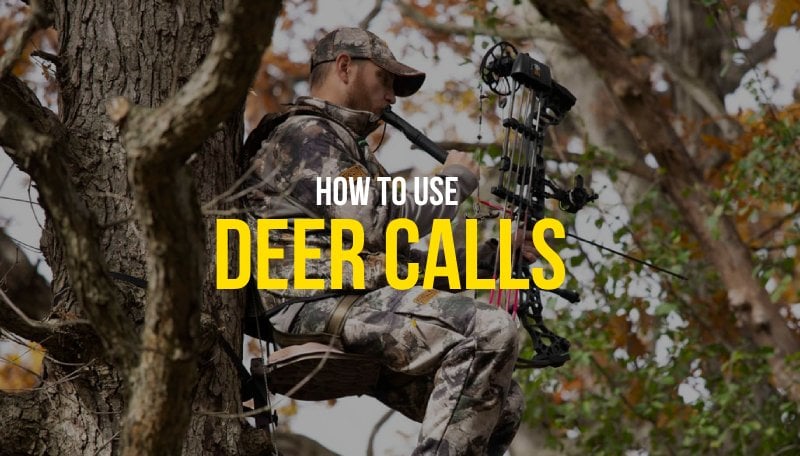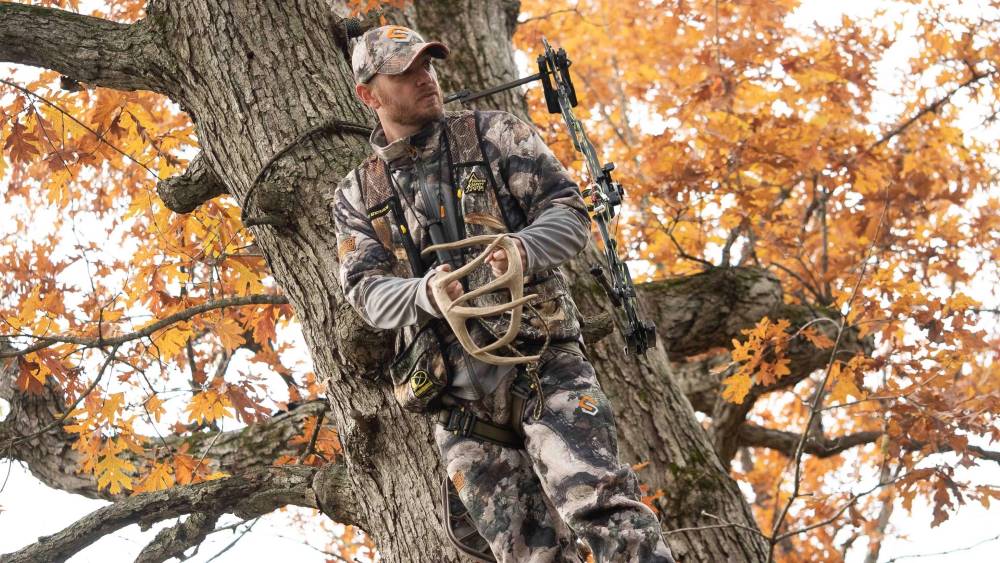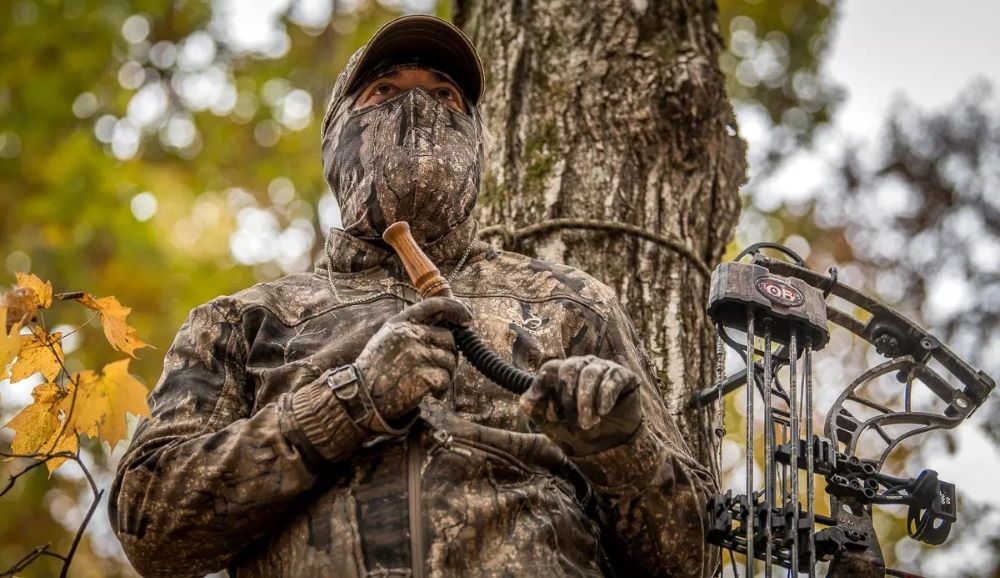
Last Updated on
Hunting is an art as much as it is a sport. It requires patience, strategy, and a deep understanding of the animal you’re pursuing. In this post, we’re going to discuss the whitetail deer sounds and what deer calls should you use. Just like speaking a foreign language, using a deer call requires practice and precision. But when mastered, it can truly transform your experience.
Contents
Quick Guide to Deer Call Sounds
How to Call Deer and What Calls to Use
Types of Whitetail Deer Calls for Hunting
Best Deer Calls for Hunting – Review
Mistakes to Avoid When Calling a Deer
Quick Guide to Deer Call Sounds
Doe Bleat is a high-pitched call used by does to communicate with each other and their fawns. It’s also used during the rut to signal that they’re ready to mate.
Fawn Bleat is a distress call used by fawns when they’re separated from their mothers.
Buck Grunt is a low, guttural sound used by bucks to communicate. There are several types of buck grunts:
Social Grunt is a casual “hello” between deer, much like humans greeting each other on the street. This sound is generally soft and short, signaling peaceful intentions.
Trailing Grunt is a sound a buck emits when pursuing a doe during the rut. It’s a series of fast-paced soft, muffled grunts.
Tending grunt is a drawn-out, more guttural sound made by a buck when he’s close to a doe in estrus.
Buck Roar is a loud, aggressive grunt used by bucks during the rut to assert dominance and ward off other males.
Snort Wheeze is a sound used primarily by dominant bucks to intimidate other males. Bucks rarely use this sound, so you should use this call only as a last resort as it may spook away non-confident bucks.
Rattling is the noise produced by two bucks locking antlers. This sound typically occurs during the breeding season or rut. It signals that two males are fighting for dominance and the right to mate with nearby does.
How to Call Deer and What Calls to Use
Early Season
During the early season, deer are not yet in rut, meaning their behavior is more relaxed and social. Doe bleats and soft grunts can be effective during this period. A doe bleat mimics the sound of a doe communicating casually with other deer. Soft grunts, on the other hand, replicate the low, guttural sounds bucks make when they’re not agitated. These sounds are non-threatening and can pique the curiosity of deer nearby. You can also try a fawn call to attract a doe or even a curious buck.
Pre-Rut
The pre-rut phase sees a shift in deer behavior. Bucks begin to search for does, making grunt calls more effective. Additionally, rattling can be useful during this time, simulating the sound of bucks sparring for dominance. This can attract other bucks looking to challenge for the right to mate.
Rut
The rut is the deer mating season, and it’s a time of high activity. During this period, aggressive grunting, rattling, and doe estrus bleats can be very effective. Bucks are highly territorial and will respond to calls that suggest a threat to their dominance, while doe bleats signal she is ready to mate.
Post-Rut
In the post-rut phase, deer activity slows down as bucks recover from the rut. However, there are still opportunities for successful hunts. Doe bleats can be effective again during this period, as bucks will still respond to potential mates.
Types of Whitetail Deer Calls for Hunting
Can Calls

Can calls imitate the bleat of a doe, which can attract both bucks and does. To use one, you simply flip it upside down and then right side up again, letting the air flow through the call to produce a sound. Remember, the slower you turn the can upside down, the smoother the call will be.
Sounds: Doe Bleats, Fawn Bleats
🟢 Very simple to use
🔴 Lack versatility
Rattle Systems

Rattle systems mimic the sound of two bucks locking antlers and can be actual antlers, bags filled with sticks, or specially designed plastic devices.
Sounds: Rattling
🟢 Effective during the rut
🔴 Quite bulky and can be noisy to carry around
Hand-Held Calls

Hand-held calls come as doe/fawn bleat balls and do-it-all grunters that adjust from fawn bleats to mature buck roars.
Sounds: Versatile or Doe/Fawn Bleats
🟢 Compact and easy to carry
🔴 Require some practice to master
Best Deer Calls for Hunting – Review
Primos Doe Bleat Call
The PRIMOS Can Family Pak offers three calls that are easy to use and produce realistic sounds that can attract both bucks and does. The Lil’ Can produces high-pitched young doe estrus bleats – perfect for the early season. The Original Can and the Great Big Can are best during the pre-rut and rut seasons. The only difference between these two is the length of the call they make. Thus, use the Great Big Can for long-range calling during windy rut days.
NB: Some hunters use Primos can calls improperly. You don’t want to just tilt it and let out a long bleat. That’s like shouting “Danger!” in deer language. Instead, you want to give it a series of short bursts. Kinda shake the can as you flip it over. This creates a bunch of quick bleats with a little pause after – just like a doe that’s ready for some company.
Primos Still Grunter Call
The Still Grunter is a classic and effective grunt call. This adjustable reed assembly allows for grunts, bleats, and everything in between, making it a versatile deer call for whitetails, blacktails, mule deer, coues deer, and even antelope. Plus, Primos has designed it to be super loud for long-range calling.
Primos Buck Grunt Call
Made from hardwood, which resonates well, this Primos deer call can effectively mimic several deer sounds. Its adjustable reed assembly and expandable tube allow for the customization of calls, meaning you can easily switch between deer sounds.
Primos Rattling Antlers
The Fightin’ Horns Deer Call is designed to mimic the sound of two bucks locked in combat. The high-tech polymer gives it the realistic sounds of antlers crashing together, without the bulk and hassle of real antlers. It’s an effective call during the rut.
Primos Deer Rattle Call
The Big Bucks Rattling Bag is another excellent rattling system from Primos. It features a compact design that’s easy to carry and produces loud, authentic sounds of big bucks fighting. It’s especially useful in areas with heavy cover where a large rattling system wouldn’t be practical.
Mistakes to Avoid When Calling a Deer
Calling Too Often
Deer are cautious creatures, and hearing constant calls can make them suspicious. Instead, use your call sparingly. Remember, less is often more when it comes to deer calling.
Using the Wrong Call
Just as humans use different tones and words for different situations, so do deer. Using a buck grunt when you should be using a doe bleat, for example, can send the wrong message. Understand the different types of deer calling sounds and when to use them.
Ignoring Wind Direction
Deer have an excellent sense of smell and can detect human scent from a distance. If you’re upwind of the deer when you call, they’ll likely smell you before they hear you. Always consider wind direction before setting up your spot and making your call.
Not Practicing Enough
Without practice, your calls may sound unnatural or forced, which can spook deer rather than attract them. Spend time practicing your calls before hunting season.
Not Adjusting to Deer Behavior
Deer behavior can change based on various factors, such as the time of year, weather conditions, and hunting pressure. What worked one day might not work the next. Be observant and flexible, adjusting your calling strategy based on what you see and hear in the field.
Read other posts:
Mastering the Art of Using Game Calls: Part 2 – Elk Calls
Mastering the Art of Using Game Calls: Part 3 – Turkey Calls
Mastering the Art of Using Game Calls: Part 4 – Duck Calls
Mastering the Art of Using Game Calls: Part 5 – Coyote Calls
FAQ
How do I call in a doe?
Doe calls typically mimic the sounds of a doe bleat or fawn distress call. To use a doe call, you’ll need to adjust the call to emit a series of short, quick bleats with small pauses in between. This simulates the sound of a doe seeking company.
How do I rattle in a buck?
Rattling in a buck involves using a set of antlers or a rattle bag to simulate the sound of two bucks fighting. Start by banging the antlers together and twisting them, then gradually increase the intensity to mimic a full-on fight. Be ready, this can attract dominant bucks looking to join the fray.
How long should I rattle for deer?
A rattling sequence should last about a minute to a minute and a half. After that, wait for about 20-30 minutes before starting another sequence. It’s important not to overdo it, as too much noise can make deer suspicious.
When should I start rattling for deer?
The best time to start rattling for deer is during the pre-rut period, which is usually late October to early November. During this time, bucks are more likely to respond to the sound of other bucks fighting over a doe. However, rattling can be effective throughout the rut period as well. Always remember to adjust your techniques based on the specific behaviors and patterns of the deer in your area.
How often should I call deer?
There’s no hard and fast rule, but generally, it’s best to call sparingly and observe how deer react to determine the best frequency. It’s generally best to wait 15-30 minutes between calls.
Does deer calling guarantee a successful hunt?
While deer calling can increase your chances, it doesn’t guarantee success. Many factors influence a successful hunt, including deer behavior, wind direction, and your stealth and patience.
When should I use a grunt call?
Grunt calls are most effective during the pre-rut and rut seasons when bucks are actively seeking does.




Leave a Reply